Healthcare System: Algorithm and Data Structure Analysis Report
VerifiedAdded on 2021/03/22
|7
|2286
|94
Report
AI Summary
This report presents an analysis of a healthcare system designed to manage patient, physician, and nurse data using object-oriented programming (OOP) and database management system (DBMS) principles. It explores the efficiency of different data structures and algorithms for managing a system with 50 physicians, 100 nurses, and approximately 1,000 patients. The report covers the application of OOP concepts, including the definition of entities, variables, ranges, and keys, to design the healthcare system. It details the essential operations such as inserting, updating, reading, sorting, searching, and deleting data. The report evaluates various search algorithms like linear search, binary search, and interpolation search, and recommends the interpolation search as the most suitable option for the healthcare sector. It also discusses the importance of proper software modification and maintenance for the system's optimal performance. The report concludes by emphasizing the need for advanced digital and database management systems in the healthcare sector and highlights the significance of the chosen algorithms for efficient data and patient information management.
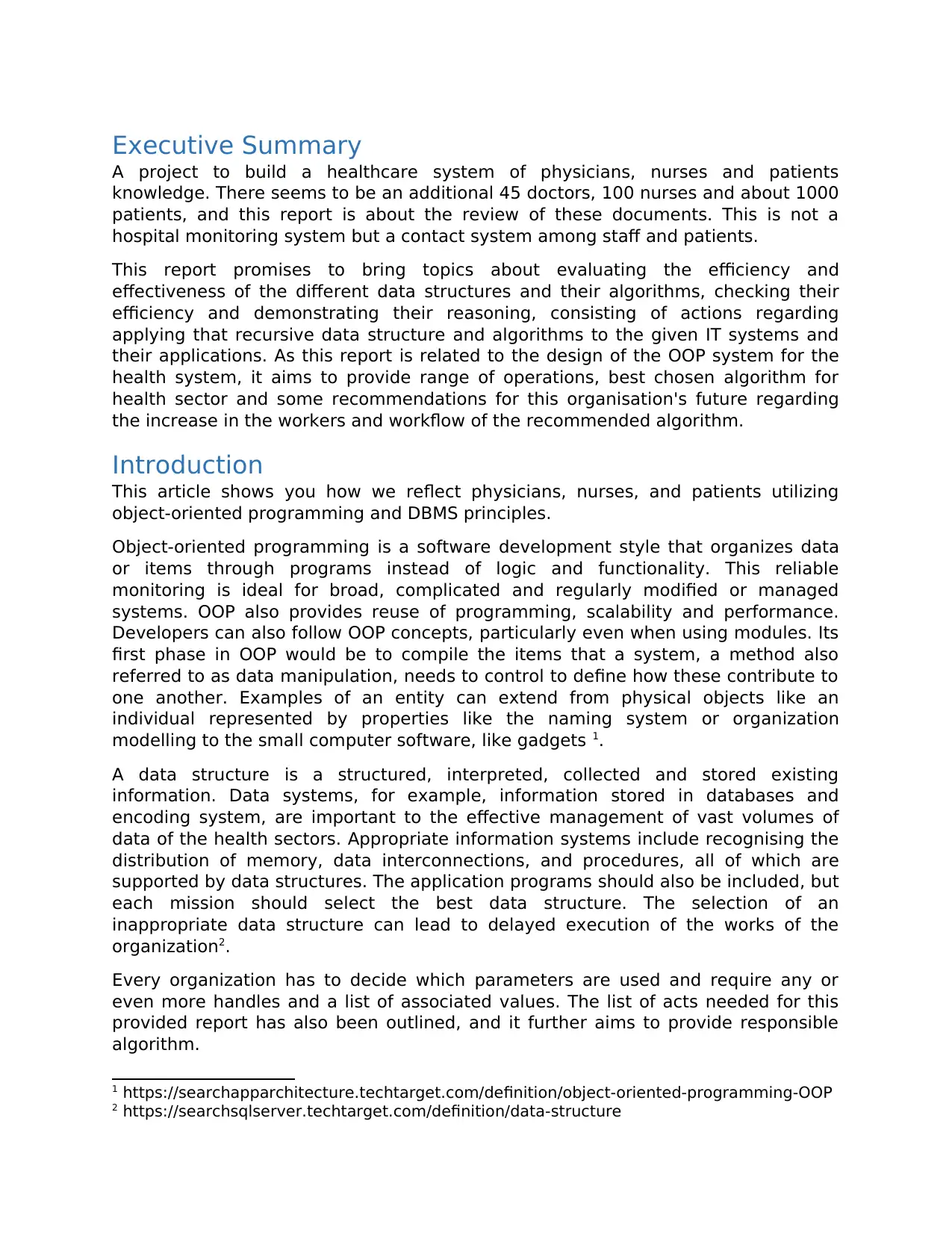
Executive Summary
A project to build a healthcare system of physicians, nurses and patients
knowledge. There seems to be an additional 45 doctors, 100 nurses and about 1000
patients, and this report is about the review of these documents. This is not a
hospital monitoring system but a contact system among staff and patients.
This report promises to bring topics about evaluating the efficiency and
effectiveness of the different data structures and their algorithms, checking their
efficiency and demonstrating their reasoning, consisting of actions regarding
applying that recursive data structure and algorithms to the given IT systems and
their applications. As this report is related to the design of the OOP system for the
health system, it aims to provide range of operations, best chosen algorithm for
health sector and some recommendations for this organisation's future regarding
the increase in the workers and workflow of the recommended algorithm.
Introduction
This article shows you how we reflect physicians, nurses, and patients utilizing
object-oriented programming and DBMS principles.
Object-oriented programming is a software development style that organizes data
or items through programs instead of logic and functionality. This reliable
monitoring is ideal for broad, complicated and regularly modified or managed
systems. OOP also provides reuse of programming, scalability and performance.
Developers can also follow OOP concepts, particularly even when using modules. Its
first phase in OOP would be to compile the items that a system, a method also
referred to as data manipulation, needs to control to define how these contribute to
one another. Examples of an entity can extend from physical objects like an
individual represented by properties like the naming system or organization
modelling to the small computer software, like gadgets 1.
A data structure is a structured, interpreted, collected and stored existing
information. Data systems, for example, information stored in databases and
encoding system, are important to the effective management of vast volumes of
data of the health sectors. Appropriate information systems include recognising the
distribution of memory, data interconnections, and procedures, all of which are
supported by data structures. The application programs should also be included, but
each mission should select the best data structure. The selection of an
inappropriate data structure can lead to delayed execution of the works of the
organization2.
Every organization has to decide which parameters are used and require any or
even more handles and a list of associated values. The list of acts needed for this
provided report has also been outlined, and it further aims to provide responsible
algorithm.
1 https://searchapparchitecture.techtarget.com/definition/object-oriented-programming-OOP
2 https://searchsqlserver.techtarget.com/definition/data-structure
A project to build a healthcare system of physicians, nurses and patients
knowledge. There seems to be an additional 45 doctors, 100 nurses and about 1000
patients, and this report is about the review of these documents. This is not a
hospital monitoring system but a contact system among staff and patients.
This report promises to bring topics about evaluating the efficiency and
effectiveness of the different data structures and their algorithms, checking their
efficiency and demonstrating their reasoning, consisting of actions regarding
applying that recursive data structure and algorithms to the given IT systems and
their applications. As this report is related to the design of the OOP system for the
health system, it aims to provide range of operations, best chosen algorithm for
health sector and some recommendations for this organisation's future regarding
the increase in the workers and workflow of the recommended algorithm.
Introduction
This article shows you how we reflect physicians, nurses, and patients utilizing
object-oriented programming and DBMS principles.
Object-oriented programming is a software development style that organizes data
or items through programs instead of logic and functionality. This reliable
monitoring is ideal for broad, complicated and regularly modified or managed
systems. OOP also provides reuse of programming, scalability and performance.
Developers can also follow OOP concepts, particularly even when using modules. Its
first phase in OOP would be to compile the items that a system, a method also
referred to as data manipulation, needs to control to define how these contribute to
one another. Examples of an entity can extend from physical objects like an
individual represented by properties like the naming system or organization
modelling to the small computer software, like gadgets 1.
A data structure is a structured, interpreted, collected and stored existing
information. Data systems, for example, information stored in databases and
encoding system, are important to the effective management of vast volumes of
data of the health sectors. Appropriate information systems include recognising the
distribution of memory, data interconnections, and procedures, all of which are
supported by data structures. The application programs should also be included, but
each mission should select the best data structure. The selection of an
inappropriate data structure can lead to delayed execution of the works of the
organization2.
Every organization has to decide which parameters are used and require any or
even more handles and a list of associated values. The list of acts needed for this
provided report has also been outlined, and it further aims to provide responsible
algorithm.
1 https://searchapparchitecture.techtarget.com/definition/object-oriented-programming-OOP
2 https://searchsqlserver.techtarget.com/definition/data-structure
Paraphrase This Document
Need a fresh take? Get an instant paraphrase of this document with our AI Paraphraser
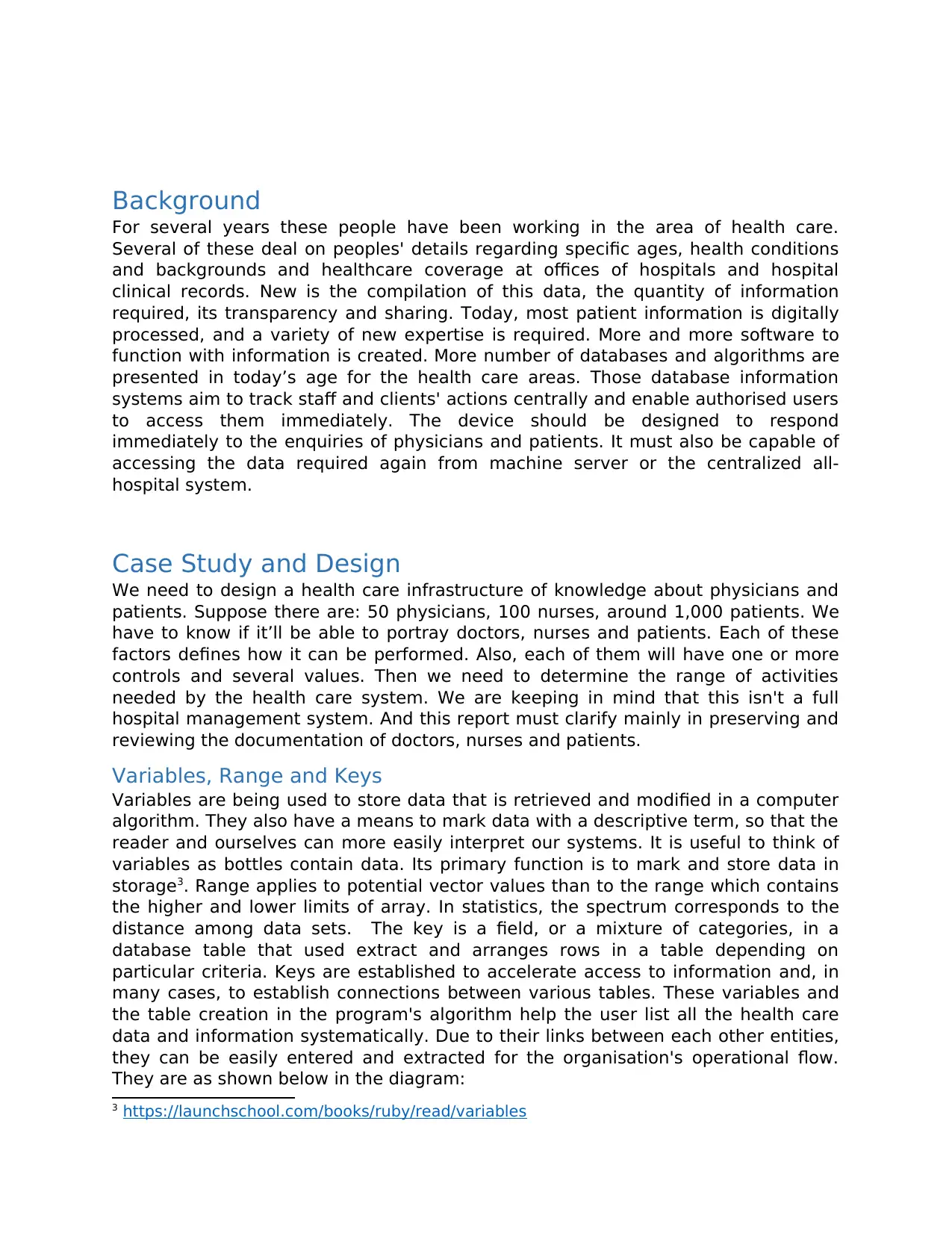
Background
For several years these people have been working in the area of health care.
Several of these deal on peoples' details regarding specific ages, health conditions
and backgrounds and healthcare coverage at offices of hospitals and hospital
clinical records. New is the compilation of this data, the quantity of information
required, its transparency and sharing. Today, most patient information is digitally
processed, and a variety of new expertise is required. More and more software to
function with information is created. More number of databases and algorithms are
presented in today’s age for the health care areas. Those database information
systems aim to track staff and clients' actions centrally and enable authorised users
to access them immediately. The device should be designed to respond
immediately to the enquiries of physicians and patients. It must also be capable of
accessing the data required again from machine server or the centralized all-
hospital system.
Case Study and Design
We need to design a health care infrastructure of knowledge about physicians and
patients. Suppose there are: 50 physicians, 100 nurses, around 1,000 patients. We
have to know if it’ll be able to portray doctors, nurses and patients. Each of these
factors defines how it can be performed. Also, each of them will have one or more
controls and several values. Then we need to determine the range of activities
needed by the health care system. We are keeping in mind that this isn't a full
hospital management system. And this report must clarify mainly in preserving and
reviewing the documentation of doctors, nurses and patients.
Variables, Range and Keys
Variables are being used to store data that is retrieved and modified in a computer
algorithm. They also have a means to mark data with a descriptive term, so that the
reader and ourselves can more easily interpret our systems. It is useful to think of
variables as bottles contain data. Its primary function is to mark and store data in
storage3. Range applies to potential vector values than to the range which contains
the higher and lower limits of array. In statistics, the spectrum corresponds to the
distance among data sets. The key is a field, or a mixture of categories, in a
database table that used extract and arranges rows in a table depending on
particular criteria. Keys are established to accelerate access to information and, in
many cases, to establish connections between various tables. These variables and
the table creation in the program's algorithm help the user list all the health care
data and information systematically. Due to their links between each other entities,
they can be easily entered and extracted for the organisation's operational flow.
They are as shown below in the diagram:
3 https://launchschool.com/books/ruby/read/variables
For several years these people have been working in the area of health care.
Several of these deal on peoples' details regarding specific ages, health conditions
and backgrounds and healthcare coverage at offices of hospitals and hospital
clinical records. New is the compilation of this data, the quantity of information
required, its transparency and sharing. Today, most patient information is digitally
processed, and a variety of new expertise is required. More and more software to
function with information is created. More number of databases and algorithms are
presented in today’s age for the health care areas. Those database information
systems aim to track staff and clients' actions centrally and enable authorised users
to access them immediately. The device should be designed to respond
immediately to the enquiries of physicians and patients. It must also be capable of
accessing the data required again from machine server or the centralized all-
hospital system.
Case Study and Design
We need to design a health care infrastructure of knowledge about physicians and
patients. Suppose there are: 50 physicians, 100 nurses, around 1,000 patients. We
have to know if it’ll be able to portray doctors, nurses and patients. Each of these
factors defines how it can be performed. Also, each of them will have one or more
controls and several values. Then we need to determine the range of activities
needed by the health care system. We are keeping in mind that this isn't a full
hospital management system. And this report must clarify mainly in preserving and
reviewing the documentation of doctors, nurses and patients.
Variables, Range and Keys
Variables are being used to store data that is retrieved and modified in a computer
algorithm. They also have a means to mark data with a descriptive term, so that the
reader and ourselves can more easily interpret our systems. It is useful to think of
variables as bottles contain data. Its primary function is to mark and store data in
storage3. Range applies to potential vector values than to the range which contains
the higher and lower limits of array. In statistics, the spectrum corresponds to the
distance among data sets. The key is a field, or a mixture of categories, in a
database table that used extract and arranges rows in a table depending on
particular criteria. Keys are established to accelerate access to information and, in
many cases, to establish connections between various tables. These variables and
the table creation in the program's algorithm help the user list all the health care
data and information systematically. Due to their links between each other entities,
they can be easily entered and extracted for the organisation's operational flow.
They are as shown below in the diagram:
3 https://launchschool.com/books/ruby/read/variables
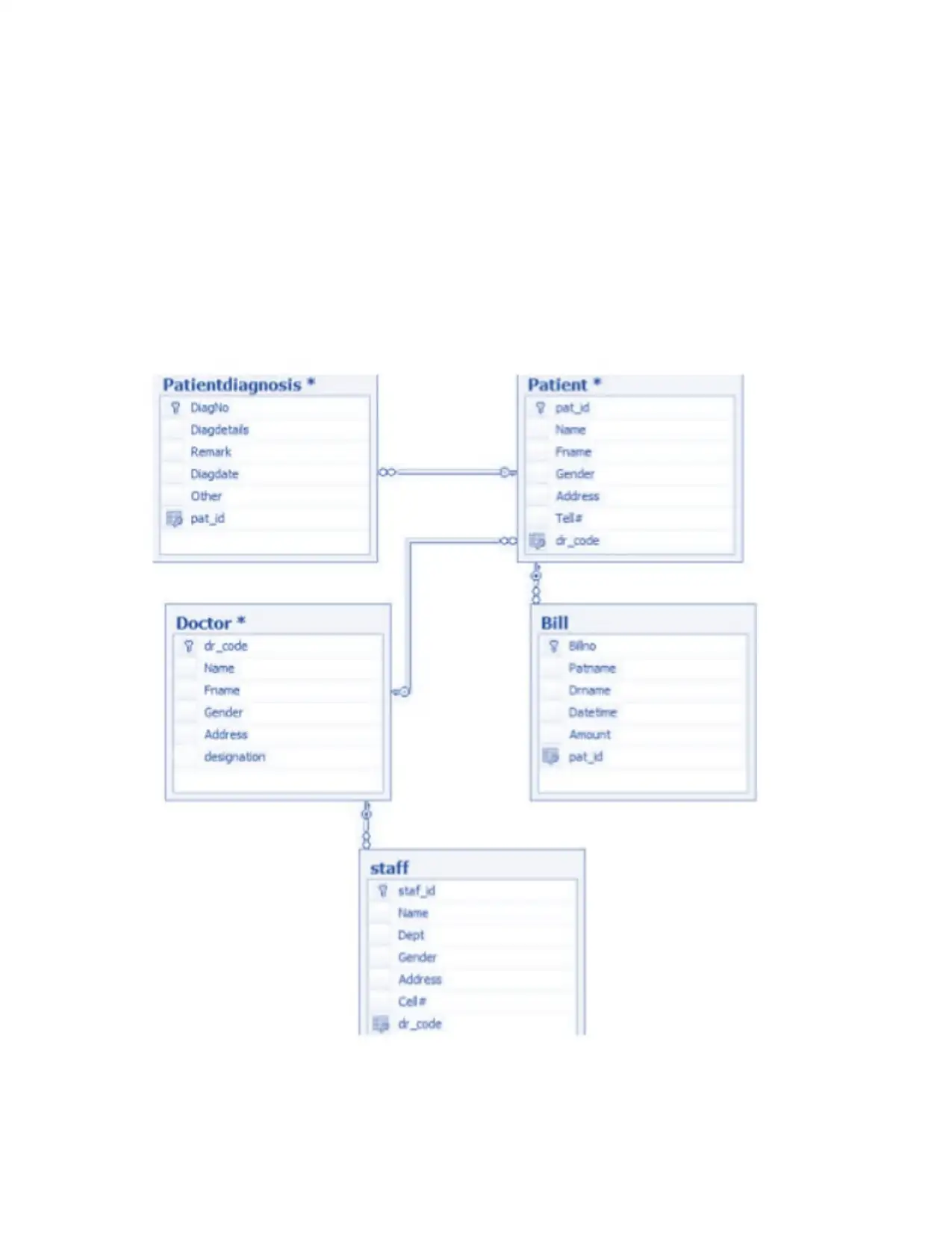
⊘ This is a preview!⊘
Do you want full access?
Subscribe today to unlock all pages.

Trusted by 1+ million students worldwide
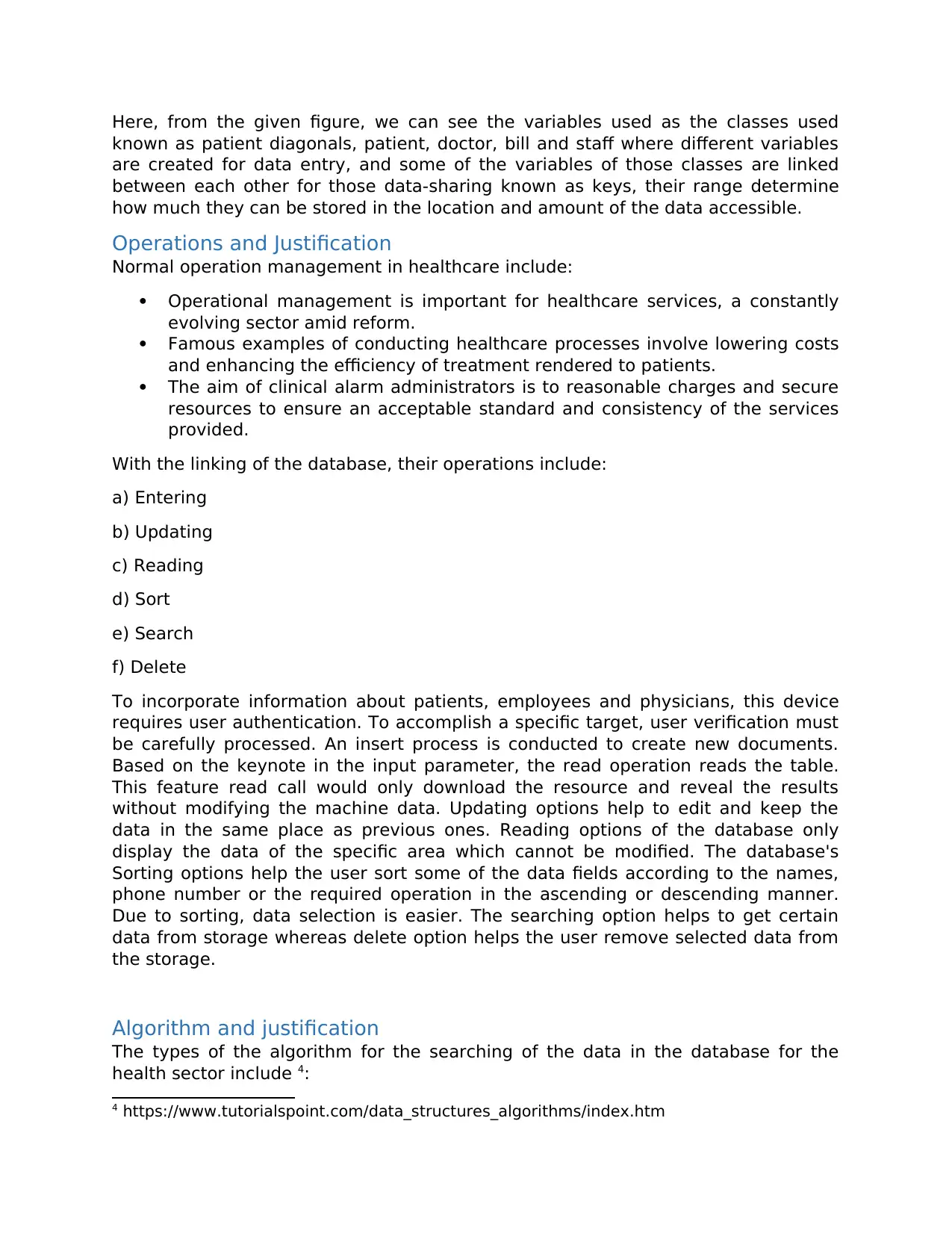
Here, from the given figure, we can see the variables used as the classes used
known as patient diagonals, patient, doctor, bill and staff where different variables
are created for data entry, and some of the variables of those classes are linked
between each other for those data-sharing known as keys, their range determine
how much they can be stored in the location and amount of the data accessible.
Operations and Justification
Normal operation management in healthcare include:
Operational management is important for healthcare services, a constantly
evolving sector amid reform.
Famous examples of conducting healthcare processes involve lowering costs
and enhancing the efficiency of treatment rendered to patients.
The aim of clinical alarm administrators is to reasonable charges and secure
resources to ensure an acceptable standard and consistency of the services
provided.
With the linking of the database, their operations include:
a) Entering
b) Updating
c) Reading
d) Sort
e) Search
f) Delete
To incorporate information about patients, employees and physicians, this device
requires user authentication. To accomplish a specific target, user verification must
be carefully processed. An insert process is conducted to create new documents.
Based on the keynote in the input parameter, the read operation reads the table.
This feature read call would only download the resource and reveal the results
without modifying the machine data. Updating options help to edit and keep the
data in the same place as previous ones. Reading options of the database only
display the data of the specific area which cannot be modified. The database's
Sorting options help the user sort some of the data fields according to the names,
phone number or the required operation in the ascending or descending manner.
Due to sorting, data selection is easier. The searching option helps to get certain
data from storage whereas delete option helps the user remove selected data from
the storage.
Algorithm and justification
The types of the algorithm for the searching of the data in the database for the
health sector include 4:
4 https://www.tutorialspoint.com/data_structures_algorithms/index.htm
known as patient diagonals, patient, doctor, bill and staff where different variables
are created for data entry, and some of the variables of those classes are linked
between each other for those data-sharing known as keys, their range determine
how much they can be stored in the location and amount of the data accessible.
Operations and Justification
Normal operation management in healthcare include:
Operational management is important for healthcare services, a constantly
evolving sector amid reform.
Famous examples of conducting healthcare processes involve lowering costs
and enhancing the efficiency of treatment rendered to patients.
The aim of clinical alarm administrators is to reasonable charges and secure
resources to ensure an acceptable standard and consistency of the services
provided.
With the linking of the database, their operations include:
a) Entering
b) Updating
c) Reading
d) Sort
e) Search
f) Delete
To incorporate information about patients, employees and physicians, this device
requires user authentication. To accomplish a specific target, user verification must
be carefully processed. An insert process is conducted to create new documents.
Based on the keynote in the input parameter, the read operation reads the table.
This feature read call would only download the resource and reveal the results
without modifying the machine data. Updating options help to edit and keep the
data in the same place as previous ones. Reading options of the database only
display the data of the specific area which cannot be modified. The database's
Sorting options help the user sort some of the data fields according to the names,
phone number or the required operation in the ascending or descending manner.
Due to sorting, data selection is easier. The searching option helps to get certain
data from storage whereas delete option helps the user remove selected data from
the storage.
Algorithm and justification
The types of the algorithm for the searching of the data in the database for the
health sector include 4:
4 https://www.tutorialspoint.com/data_structures_algorithms/index.htm
Paraphrase This Document
Need a fresh take? Get an instant paraphrase of this document with our AI Paraphraser
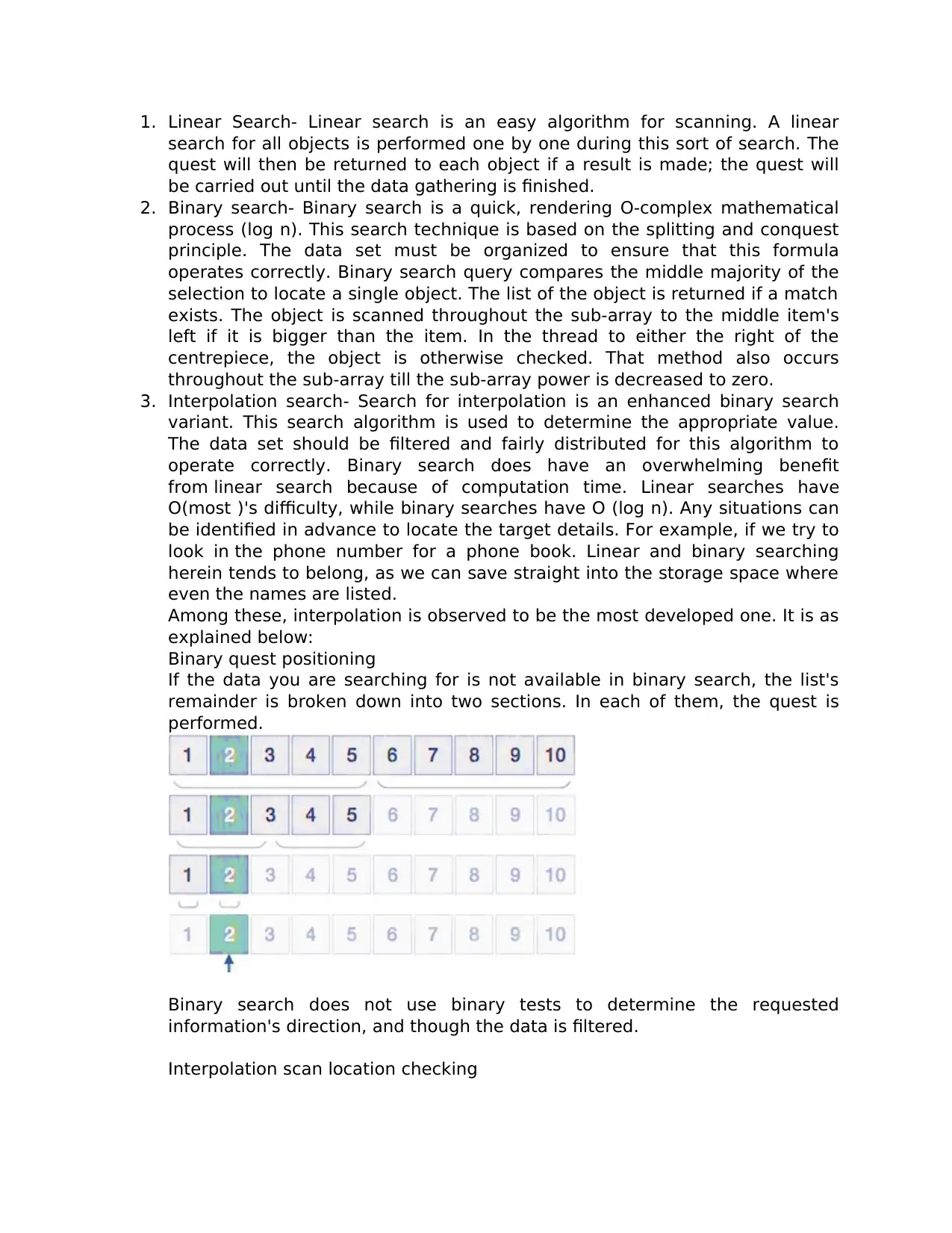
1. Linear Search- Linear search is an easy algorithm for scanning. A linear
search for all objects is performed one by one during this sort of search. The
quest will then be returned to each object if a result is made; the quest will
be carried out until the data gathering is finished.
2. Binary search- Binary search is a quick, rendering O-complex mathematical
process (log n). This search technique is based on the splitting and conquest
principle. The data set must be organized to ensure that this formula
operates correctly. Binary search query compares the middle majority of the
selection to locate a single object. The list of the object is returned if a match
exists. The object is scanned throughout the sub-array to the middle item's
left if it is bigger than the item. In the thread to either the right of the
centrepiece, the object is otherwise checked. That method also occurs
throughout the sub-array till the sub-array power is decreased to zero.
3. Interpolation search- Search for interpolation is an enhanced binary search
variant. This search algorithm is used to determine the appropriate value.
The data set should be filtered and fairly distributed for this algorithm to
operate correctly. Binary search does have an overwhelming benefit
from linear search because of computation time. Linear searches have
O(most )'s difficulty, while binary searches have O (log n). Any situations can
be identified in advance to locate the target details. For example, if we try to
look in the phone number for a phone book. Linear and binary searching
herein tends to belong, as we can save straight into the storage space where
even the names are listed.
Among these, interpolation is observed to be the most developed one. It is as
explained below:
Binary quest positioning
If the data you are searching for is not available in binary search, the list's
remainder is broken down into two sections. In each of them, the quest is
performed.
Binary search does not use binary tests to determine the requested
information's direction, and though the data is filtered.
Interpolation scan location checking
search for all objects is performed one by one during this sort of search. The
quest will then be returned to each object if a result is made; the quest will
be carried out until the data gathering is finished.
2. Binary search- Binary search is a quick, rendering O-complex mathematical
process (log n). This search technique is based on the splitting and conquest
principle. The data set must be organized to ensure that this formula
operates correctly. Binary search query compares the middle majority of the
selection to locate a single object. The list of the object is returned if a match
exists. The object is scanned throughout the sub-array to the middle item's
left if it is bigger than the item. In the thread to either the right of the
centrepiece, the object is otherwise checked. That method also occurs
throughout the sub-array till the sub-array power is decreased to zero.
3. Interpolation search- Search for interpolation is an enhanced binary search
variant. This search algorithm is used to determine the appropriate value.
The data set should be filtered and fairly distributed for this algorithm to
operate correctly. Binary search does have an overwhelming benefit
from linear search because of computation time. Linear searches have
O(most )'s difficulty, while binary searches have O (log n). Any situations can
be identified in advance to locate the target details. For example, if we try to
look in the phone number for a phone book. Linear and binary searching
herein tends to belong, as we can save straight into the storage space where
even the names are listed.
Among these, interpolation is observed to be the most developed one. It is as
explained below:
Binary quest positioning
If the data you are searching for is not available in binary search, the list's
remainder is broken down into two sections. In each of them, the quest is
performed.
Binary search does not use binary tests to determine the requested
information's direction, and though the data is filtered.
Interpolation scan location checking
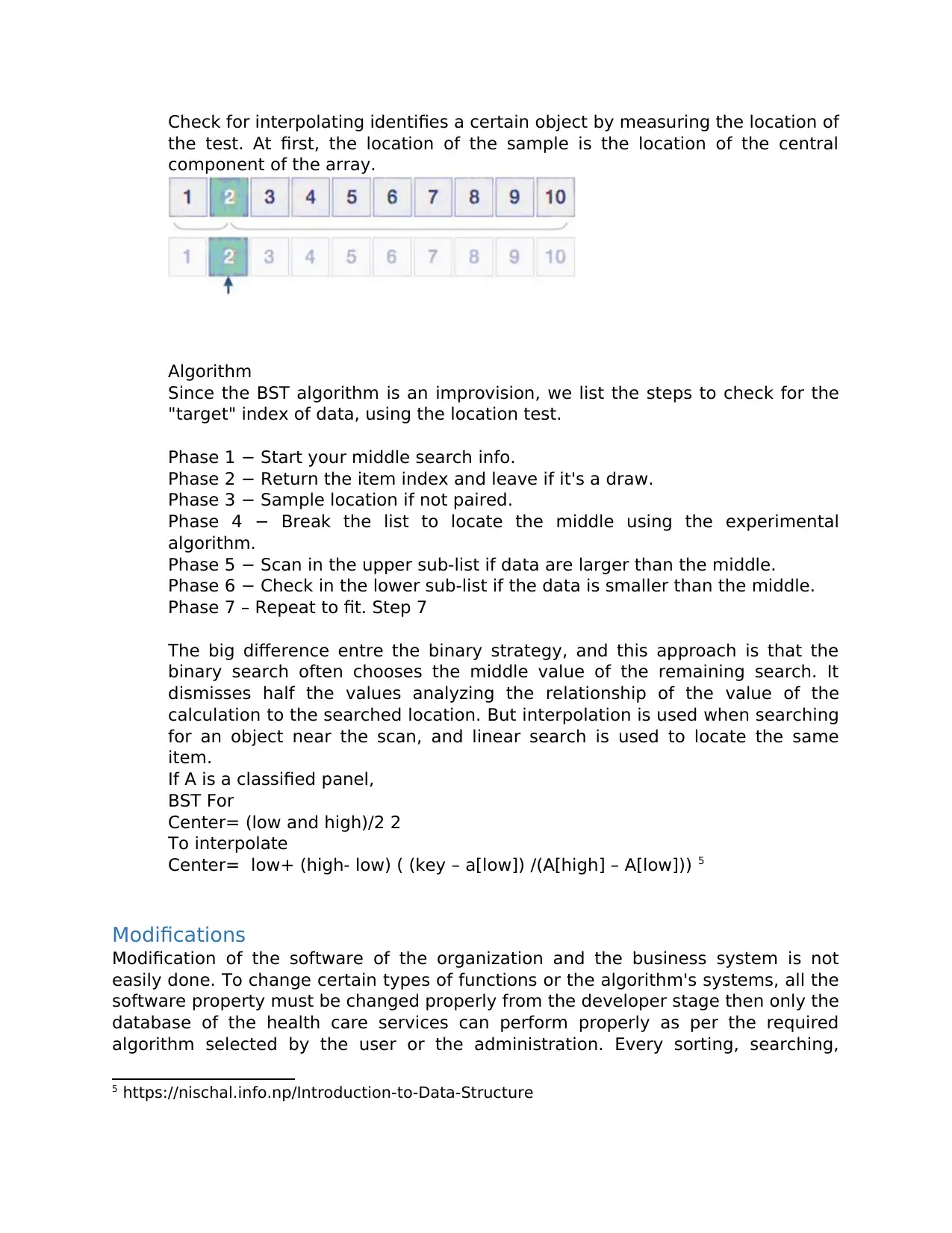
Check for interpolating identifies a certain object by measuring the location of
the test. At first, the location of the sample is the location of the central
component of the array.
Algorithm
Since the BST algorithm is an improvision, we list the steps to check for the
"target" index of data, using the location test.
Phase 1 − Start your middle search info.
Phase 2 − Return the item index and leave if it's a draw.
Phase 3 − Sample location if not paired.
Phase 4 − Break the list to locate the middle using the experimental
algorithm.
Phase 5 − Scan in the upper sub-list if data are larger than the middle.
Phase 6 − Check in the lower sub-list if the data is smaller than the middle.
Phase 7 – Repeat to fit. Step 7
The big difference entre the binary strategy, and this approach is that the
binary search often chooses the middle value of the remaining search. It
dismisses half the values analyzing the relationship of the value of the
calculation to the searched location. But interpolation is used when searching
for an object near the scan, and linear search is used to locate the same
item.
If A is a classified panel,
BST For
Center= (low and high)/2 2
To interpolate
Center= low+ (high- low) ( (key – a[low]) /(A[high] – A[low])) 5
Modifications
Modification of the software of the organization and the business system is not
easily done. To change certain types of functions or the algorithm's systems, all the
software property must be changed properly from the developer stage then only the
database of the health care services can perform properly as per the required
algorithm selected by the user or the administration. Every sorting, searching,
5 https://nischal.info.np/Introduction-to-Data-Structure
the test. At first, the location of the sample is the location of the central
component of the array.
Algorithm
Since the BST algorithm is an improvision, we list the steps to check for the
"target" index of data, using the location test.
Phase 1 − Start your middle search info.
Phase 2 − Return the item index and leave if it's a draw.
Phase 3 − Sample location if not paired.
Phase 4 − Break the list to locate the middle using the experimental
algorithm.
Phase 5 − Scan in the upper sub-list if data are larger than the middle.
Phase 6 − Check in the lower sub-list if the data is smaller than the middle.
Phase 7 – Repeat to fit. Step 7
The big difference entre the binary strategy, and this approach is that the
binary search often chooses the middle value of the remaining search. It
dismisses half the values analyzing the relationship of the value of the
calculation to the searched location. But interpolation is used when searching
for an object near the scan, and linear search is used to locate the same
item.
If A is a classified panel,
BST For
Center= (low and high)/2 2
To interpolate
Center= low+ (high- low) ( (key – a[low]) /(A[high] – A[low])) 5
Modifications
Modification of the software of the organization and the business system is not
easily done. To change certain types of functions or the algorithm's systems, all the
software property must be changed properly from the developer stage then only the
database of the health care services can perform properly as per the required
algorithm selected by the user or the administration. Every sorting, searching,
5 https://nischal.info.np/Introduction-to-Data-Structure
⊘ This is a preview!⊘
Do you want full access?
Subscribe today to unlock all pages.

Trusted by 1+ million students worldwide
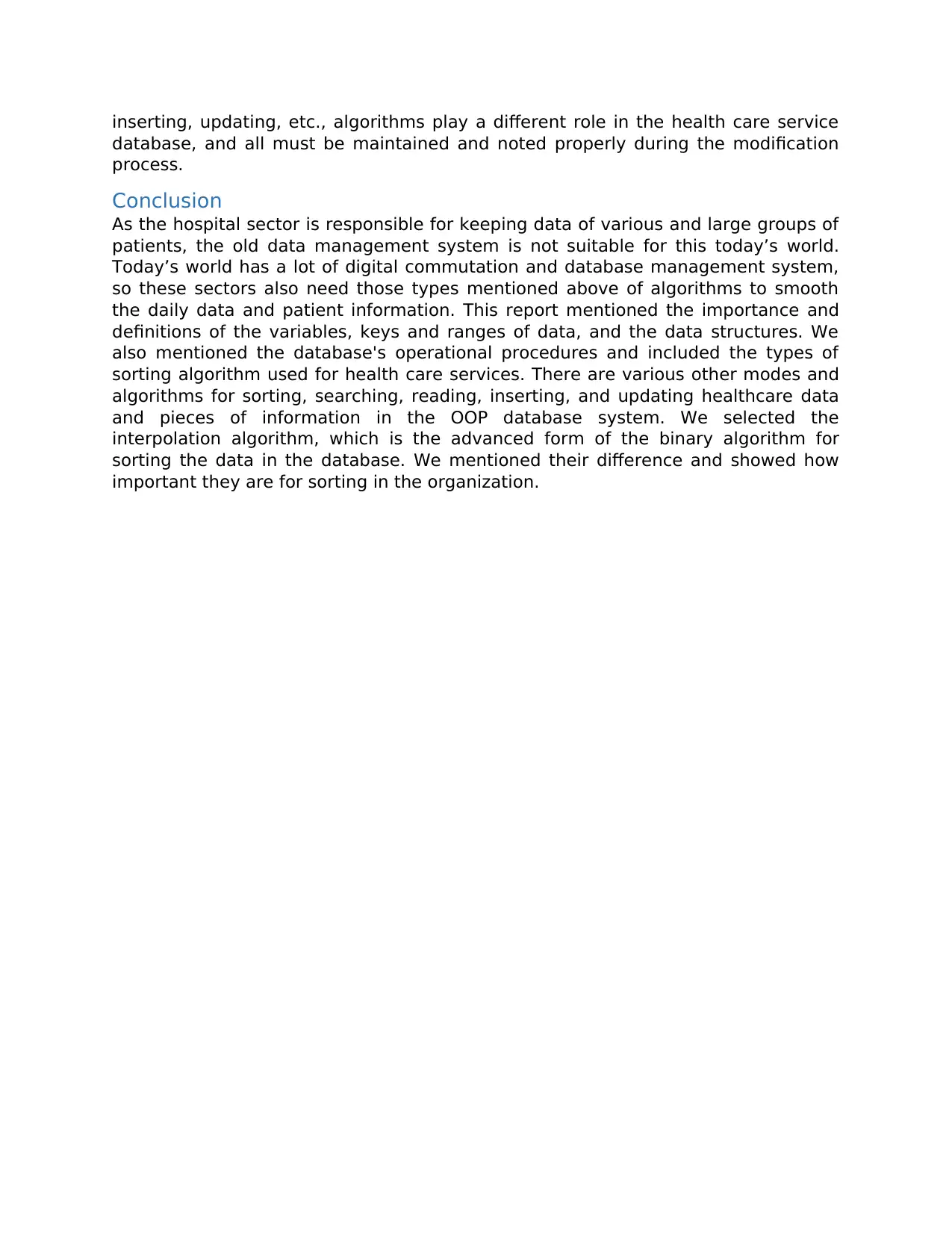
inserting, updating, etc., algorithms play a different role in the health care service
database, and all must be maintained and noted properly during the modification
process.
Conclusion
As the hospital sector is responsible for keeping data of various and large groups of
patients, the old data management system is not suitable for this today’s world.
Today’s world has a lot of digital commutation and database management system,
so these sectors also need those types mentioned above of algorithms to smooth
the daily data and patient information. This report mentioned the importance and
definitions of the variables, keys and ranges of data, and the data structures. We
also mentioned the database's operational procedures and included the types of
sorting algorithm used for health care services. There are various other modes and
algorithms for sorting, searching, reading, inserting, and updating healthcare data
and pieces of information in the OOP database system. We selected the
interpolation algorithm, which is the advanced form of the binary algorithm for
sorting the data in the database. We mentioned their difference and showed how
important they are for sorting in the organization.
database, and all must be maintained and noted properly during the modification
process.
Conclusion
As the hospital sector is responsible for keeping data of various and large groups of
patients, the old data management system is not suitable for this today’s world.
Today’s world has a lot of digital commutation and database management system,
so these sectors also need those types mentioned above of algorithms to smooth
the daily data and patient information. This report mentioned the importance and
definitions of the variables, keys and ranges of data, and the data structures. We
also mentioned the database's operational procedures and included the types of
sorting algorithm used for health care services. There are various other modes and
algorithms for sorting, searching, reading, inserting, and updating healthcare data
and pieces of information in the OOP database system. We selected the
interpolation algorithm, which is the advanced form of the binary algorithm for
sorting the data in the database. We mentioned their difference and showed how
important they are for sorting in the organization.
1 out of 7
Related Documents
Your All-in-One AI-Powered Toolkit for Academic Success.
+13062052269
info@desklib.com
Available 24*7 on WhatsApp / Email
![[object Object]](/_next/static/media/star-bottom.7253800d.svg)
Unlock your academic potential
Copyright © 2020–2025 A2Z Services. All Rights Reserved. Developed and managed by ZUCOL.





